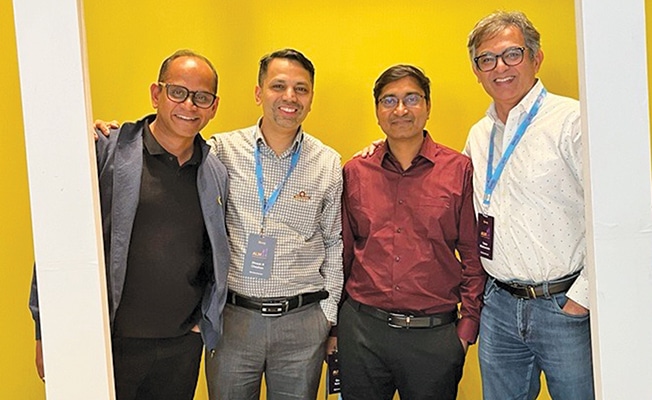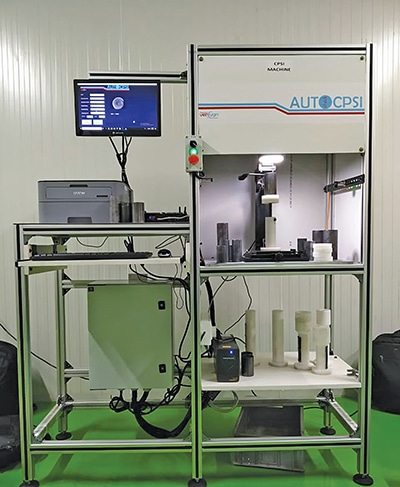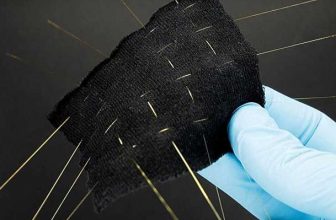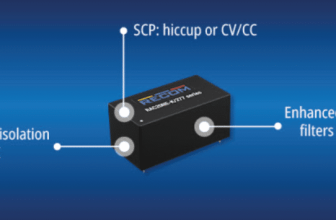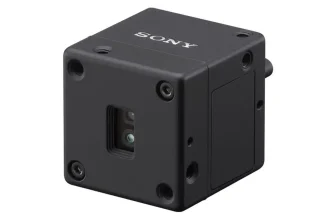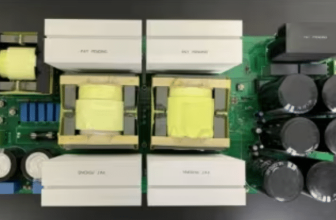
Check out our latest products
A high-stakes game of precision and strategy, the EMS industry is complex. Delving into ways of mastering its challenges with a customer-centric approach, Sudharsan Ramajeyam of Thinksemi Infotech narrates their journey to EFY’s Nitisha Dubey and Nidhi Agarwal.

Q. What services does your company provide in electronics manufacturing and distribution?
A. We operate across four key verticals within the electronic system design and manufacturing (ESDM) sector. Our expertise spans research and development, electronic component distribution, electronic manufacturing services (EMS), and wire harnessing solutions. From initial design to full-scale production, we provide end-to-end solutions across all four verticals.
Q. Who are your target customers?
A. Our primary target customers are the automotive original equipment manufacturer (OEM) sector, which drives our revenue. In this segment, all of them are provided direct support. We also cater to clients who require design, development, reverse engineering, and new product development solutions.
Q. How do you categorise your customers regarding job, function, industry, and seniority?
A. As I said, customers are across industries, mainly the automotive and medical sectors. In automotive, we work with both traditional and electric vehicle (EV) manufacturers, ensuring our solutions align with industry advancements. A large part of our revenue comes from medical device manufacturers too. We also work with companies in the Internet of Things (IoT) sector and home appliances industry, but revenue from these segments varies based on market trends. Our customers span executives, engineers, procurement teams, and product development professionals.
– Advertisement –
Q. Would you like to call yourself an original design manufacturer?
A. No, we are not an original design manufacturer (ODM). We are a design-based, tailor-made manufacturing company. Our work is to support both customer-provided designs as well as our in-house developed designs with end-to-end manufacturing solutions. Whether a customer brings their own design or needs assistance to create a new one from scratch, we can handle both. Our team is capable of helping from the initial concept through to the finished product.
Q. Do you have specialised teams to manage new product projects coming from a client?
A. Yes, we have a dedicated new product development (NPD) team and a cross-functional team (CFT) to ensure a seamless development process. The NPD team is responsible for evaluating technical feasibility, validating the bill of materials (BOM), reviewing Gerber files, and supporting customer-provided samples. Meanwhile, the CFT focuses on analysing project timelines, identifying potential challenges, and planning the production process for smooth execution. Together, these teams carry out all necessary preliminary assessments before actual production begins, ensuring efficiency and minimising risks.
Q. What are the main steps involved from talking to a client to delivering the finished product?
A. Understanding customer challenges is key to delivering a reliable product. Our R&D team categorises queries into fresh ideas or reverse engineering needs. For reverse engineering, we analyse samples to identify components and take necessary actions. For fresh ideas, our design team works with the component team to check market availability and potential end-of-life (EOL) risks. Early discussions among R&D, CFT, and component teams help create a BOM with multiple approved vendor list (AVL) options to reduce production dependencies.
Once designs and prototypes are approved, we coordinate with manufacturers on component availability, cycle times, and printed circuit board (PCB) requirements. PCB design aligns with EMS capabilities and follows CFT team inputs. Gerber file creation and alignment are set up for our production process. Box-building and wiring harness teams ensure that connector specifications meet required standards. Each team is involved at every stage to complete projects smoothly with minimal issues.
Q. How does the R&D team support product development?
A. Currently, it supports power electronics and brushless direct current (BLDC)-based solutions. When customers need design and development services, even from other industries, we connect them with the right experts to develop product solutions. We also handle BOM design and optimisation to help reduce product costs. This approach allows customers to access complete solutions in one place.
Q. Tell us more about your R&D team.
A. Our R&D team hails from an Indian Institute of Technology Madras (IIT-M) research incubation background and brings deep technical expertise across multiple domains. They specialise in reverse engineering, new product development, and solving complex challenges at both the design and manufacturing stages. Highly responsive to customer inputs, the team excels at understanding unique requirements and delivering tailored solutions with speed and precision.
Q. How do you manage to manufacture products for diverse sectors efficiently?
A. We have assigned leaders to each business sector to ensure smooth management and customer support. A leader will oversee customer needs in the automotive sector, while another will manage the telecommunications sector. These leaders will handle operations, coordinate with customers, and ensure efficient processes.
Our facility has three automatic production lines. One is dedicated to research, development, and small production runs, while the other two focus on mass production. With nine shifts running daily, we efficiently meet demand. A real-time dashboard tracks operations, and any issues are quickly resolved. Separating the production lines prevents conflicts, allowing both R&D and large-scale manufacturing to run without delays.
Q. How do you ensure quality across R&D and mass production lines? Do you have two different quality control teams?
A. Each production line has its own set of line inspectors, NPD, and CFT members to maintain strict and specialised quality control (QC). To ensure quality across both R&D and production, we follow a robust multi-stage QC process. It begins with incoming quality control (IQC), where all incoming materials are thoroughly inspected. During production, in-process control (IPC) monitors each stage to maintain consistency and accuracy. We also employ automated optical inspection (AOI) to detect visual defects, while dedicated through-hole (PTH) and PCB design specification (PDS) quality control teams handle inspections specific to through-hole components and PCB boards. Finally, our products undergo a thorough check by final QC inspectors before dispatch. In total, we perform quality checks at eight to twelve critical stages, ensuring high reliability and near-zero rejection rates.
Q. What happens if a production line stops working?
A. There are robust offline solutions and contingency plans in place to ensure uninterrupted production. Processes such as programme loading, component preparation, and image processing are handled offline in advance. This allows us to seamlessly transition to the next product setup within just five to ten minutes if a production line stops. As a result, we eliminate any bottlenecks or delays caused by machine downtime.
Q. How do you make sure prototypes match the final product?
A. When launching a product, challenges often arise that require iterative improvements until the customer is satisfied with testing. Environmental factors are also considered. If a customer needs an outer enclosure, we assess whether it should be metal or plastic and ensure it does not affect electronic components. Protection against water, dust, and pollutants is important for proper function. We collect customer input on application conditions and segment requirements to design suitable circuits, enclosures, and protection systems such as IP65, IP67, or IP68-rated solutions. Understanding customer challenges helps in delivering a functional product.
Q. What were the challenges in moving from prototype to mass production?
A. Many companies design their products using commonly available components, similar to the approach in Korea, China, and Taiwan. They base their designs on market availability and finalise them during the R&D phase. We follow the same strategy, selecting components that are easy to source and have shorter lead times. This approach allows a smooth transition into production without challenges related to component changes. Addressing potential issues during the design stage can prevent future production obstacles.
Q. What are the challenges in design changes?
A. We gather customer input based on their feedback and handle design and development activities. If modifications are needed in existing designs, we ask customers to specify the required changes, whether for the entire design or a specific section like power input, frequency, module updates, or communication interfaces. Since multiple segments are involved, we listen to the customer to identify necessary modifications for a new version, such as Version 1.2. Instead of redesigning everything, we focus only on the required changes. This ensures that any connectivity, power, or functionality issues are addressed.
Q. What type of machines do you use in your manufacturing process? Do you prefer new or second-hand machines?
A. We always invest in brand-new machines rather than second-hand equipment. Using new machines ensures consistent product quality, lowers production downtime, and supports high-volume manufacturing. Second-hand machines often come with operational risks, lack proper certification records, and may require frequent maintenance, leading to production delays. With new machines, we benefit from manufacturer support, including service personnel who can quickly resolve any technical issues within 30 minutes to an hour.
Q. Do you use automation in production? If yes, then how?
A. We do. Three fully automated production lines are designed to reduce cycle times and minimise manpower requirements. Once the PCB enters the system, the fully assembled product emerges at the other end, ensuring a seamless, hands-free process. Each line requires only three to four personnel for supervision, emphasising full automation. Our factory specialises in PCB assembly with complete automation.
Q. How do you keep equipment working and avoid breakdowns?
A. We are implementing an artificial intelligence (AI)-driven system within our manufacturing execution system (MES) to enhance efficiency. This system connects all manufacturing equipment to a central server, enabling automated monitoring and notifications. For instance, if two preventive maintenance sessions are scheduled for the month, the system triggers alerts in advance, typically two days prior, reminding us to initiate maintenance. This ensures timely coordination with machine manufacturers for servicing. AI plays a crucial role in automating reminders for annual maintenance contract (AMC) and machine maintenance. Additionally, a team is there to manage and oversee this system.
Q. What is the role of AI in modern electronic manufacturing? Are you using it?
A. AI-driven calculations for component modifications optimise our cycle time. The AI module that we use analyses machine cycle times, evaluates the BOM to identify repetitive components on both top and bottom layers, and adjusts machine operations accordingly. We reduce unnecessary loading and unloading by selecting the best option, preventing time wastage. This AI-based approach, again, reduces changeover time, improves machine efficiency, and ensures smooth production workflows while maintaining productivity.
Q. How do you do quality control?
A. Our quality control follows strict parameters, adhering to Institute for Printed Circuits (IPC), International Automotive Task Force (IATF) for automotive, and International Organization for Standardization (ISO) standards. We have in-house testing facilities, including AI-driven surface mount technology (SMT), 3D solid-based printing, X-ray inspection, and in-circuit testing (ICT) for feasibility and functional hardware tests. Additionally, our functional circuit testing (FCT) verifies complete box-build assemblies. With in-house testing labs, we ensure production stability and reduce field issues. All tests are conducted internally with advanced equipment.
Q. How do you differentiate yourself from other EMS companies?
A. We differ from other EMS companies by integrating core capabilities under one roof: electronic component distribution, wiring harness manufacturing, R&D, and EMS. Unlike EMS companies that use third-party sourcing teams, Thinksemi procures materials directly from manufacturers, removing dependency on external suppliers. This approach reduces manufacturing costs, improves control over quality, and optimises lead times.
With an in-house R&D team and wiring harness manufacturing, Thinksemi provides end-to-end solutions without multiple vendors, offering advantages in cost, supply chain reliability, and development.
Q. What is your current production capacity?
A. We have a production capacity of 15,000 soft boards per day.
Q. How do you handle component sourcing?
A. We have a strong global sourcing network with offices in Hong Kong and Singapore. We are also a direct authorised distributor for 25 to 30 component lines.
Q. Do you use only Indian components, or do you also get them from other countries?
A. While we have recently started electronic component packaging in India, currently, about 75 to 80 per cent of our components are sourced from overseas, including Korea, China, Taiwan, and other regions. We utilise Indian-manufactured components whenever they are available.
Q. How do you ensure the authenticity and traceability of components?
A. For authorised components, we provide a certificate of conformance (COC) from the manufacturer. If a customer requires components from non-authorised sources, we support them by obtaining White Laboratory certification for counterfeit traceability. Additionally, we ensure original certification from manufacturers and independent laboratories for verification.
Q. What strategies do you use for supply chain management?
A. We have a supply chain management system handled by professionals with 12 to 15 years of experience. Our sourcing team in Singapore has access to global markets. They identify suppliers, check stock availability, and reduce counterfeit risks. We follow verification processes to ensure all sourced components are original, using various platforms to assess authenticity. Moreover, an exclusive customs house agent (CHA) manages import processes. By prearranging customs clearances, we avoid delays and maintain supply chain flow. The Singapore-based team consolidates multiple components under a single invoice before shipping to India, which reduces cost and streamlines operations.
Q. How do you ensure timely delivery?
A. We ensure timely delivery by carefully planning production timelines and proactively managing all preliminary steps. For prototype and pilot manufacturing, we commit to a six to eight-week timeline, while volume production takes 12 to 15 weeks, depending on component availability.
To avoid delays, our R&D team reviews the BOM early to identify and replace any problematic components. If a component has a long lead time, we find suitable alternatives that do not impact circuit functionality. Additionally, our efficient global sourcing is an advantage; we can quickly check stock availability and secure critical components. These measures help us meet delivery commitments.
Q. What decides a project’s cost?
A. It depends on the segment and the customer’s requirements. For example, if a customer requests an annual quantity of 50,000 or 100,000 units, we design accordingly. The design and costing process is tailored to the specific segment, whether home appliances, IoT, automotive, or medical. The segment and quantity are crucial in determining our design strategy and cost estimation.
Q. What are your payment cycle terms?
A. We follow a structured payment cycle based on micro, small, and medium enterprises (MSME) terms. For customers falling under the MSME category, we offer a 45-day payment cycle as per standard industry practices. A few customers also operate on a 60-day cycle, depending on mutual agreements. We ensure that our payment structure supports customers while maintaining a balanced financial workflow. Our adherence to MSME terms ensures smooth cash flow and helps us maintain a strong business relationship with our partners.
Q. Do you face any major obstacles in this industry?
A. Not yet, because, you see, the Indian government supports local manufacturing through policies. The 30 per cent anti-dumping duties on imported PCBs provide an opportunity for domestic manufacturers to increase production. This initiative strengthens the Indian electronics ecosystem and reduces reliance on imports. The hurdles associated with the payment cycle are limited; most customers follow the MSME standard terms as discussed.
Q. What is new in high-precision electronics?
A. Many manufacturers embrace AI-based machinery to reduce cycle times and improve cost efficiency. As I said before, we use them too. These machines now support even the most minor electronic components, making it easier to populate boards with precision. Whether dealing with large or small components, they offer seamless adaptability. Currently, we source our machines from Japan. Japanese manufacturers have integrated AI into their machines to simplify operations, minimise complexities, and enhance productivity.
Q. How do you see the competition in this field?
A. We do not see ourselves as competitors to others; instead, we focus solely on our vision and goals. India has long depended on China for turn-key solutions and components, but the government’s ‘Make in India’ initiative now prioritizes local manufacturing over imports. Subsidies have boosted this shift, prompting more customers to choose domestic manufacturers.
Q. What has been your sales and revenue growth from last year to this year?
A. This company was founded in 2016 with an initial annual revenue of approximately ₹12 million. Over the years, it has experienced significant growth, reaching ₹750 million in annual revenue today. This growth can be attributed to our component sourcing, strong manufacturing capabilities, and customer-focused approach.
Q. Are all your employees engineers?
A. No, not all of them are engineers. Approximately 65 per cent of our workforce consists of skilled manpower, while the remaining employees come from diverse backgrounds. We maintain a balanced team to ensure efficiency across all aspects of the business.
Q. What are your key hiring strategies for attracting top talent?
A. We focus more on loyalty and trust rather than just technical skills. While skills can be developed through training, loyalty and trust are qualities that define long-term employee relationships. We believe that employees who are committed and trustworthy can be trained to become skilled professionals. This philosophy has helped us build a dedicated and reliable workforce contributing to the company’s growth.
Q. What are the current training trends in the industry, and how do you train your employees?
A. Training in our industry is primarily handled by experienced professionals who pass on their expertise to new team members. At Thinksemi, we have appointed two senior personnel, each with 10 to 15 years of industry experience, to oversee training programmes. These experts ensure that employees gain the necessary technical knowledge and hands-on experience required for production activities.
Q. Does your company receive any government support?
A. Yes, we actively utilise all government subsidies and support programmes available to our industry. We consistently work with government initiatives that promote local manufacturing and help companies scale their operations.
Q. How important is a website and digital marketing in your business growth? What digital marketing techniques have been most effective for you?
A. Digital marketing has played a significant role in expanding Thinksemi’s reach. Initially, we relied on direct customer visits, but as our company grew, we realised the potential of digital platforms. Our marketing team has been instrumental in boosting brand visibility across India and globally. Besides, social media platforms, especially LinkedIn, have been key in generating new business leads.
Our investment in digital marketing has helped us connect with more customers, increase brand recognition, and drive revenue growth. Currently, 25 to 30% of our revenue comes from leads generated through that.
Q. What are your marketing strategies for growing the company?
A. Rather than relying on aggressive marketing strategies, our approach is to understand customer pain points and provide solutions that address the issues they face. I repeat this again and again. Many customers face difficulties related to delayed deliveries, high procurement costs, transportation bottlenecks, and supply chain disruptions. We look to identify these problems and offer timely, cost-effective solutions. This customer-centric approach has been the key to our business growth.


![[5G & 2.4G] Indoor/Outdoor Security Camera for Home, Baby/Elder/Dog/Pet Camera with Phone App, Wi-Fi Camera w/Spotlight, Color Night Vision, 2-Way Audio, 24/7, SD/Cloud Storage, Work w/Alexa, 2Pack](https://m.media-amazon.com/images/I/71gzKbvCrrL._AC_SL1500_.jpg)



![[3 Pack] Sport Bands Compatible with Fitbit Charge 5 Bands Women Men, Adjustable Soft Silicone Charge 5 Wristband Strap for Fitbit Charge 5, Large](https://m.media-amazon.com/images/I/61Tqj4Sz2rL._AC_SL1500_.jpg)
